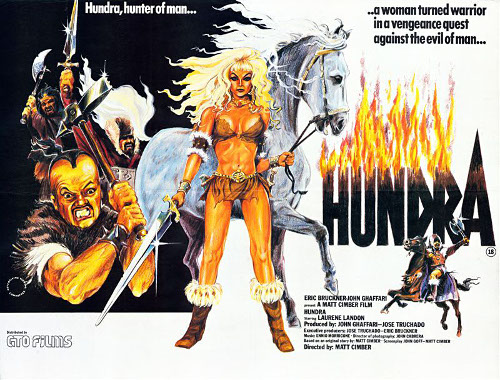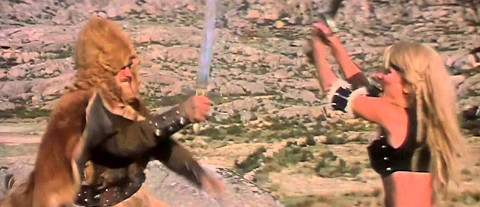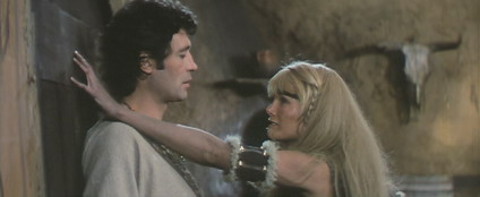Hundra (1983)
Directed by: Matt Cimber
Written by: John F. Goff, Matt Cimber
Starring: John Ghaffari, Laurene Landon, María Casal, Ramiro Oliveros
Spain/USA
AVAILABLE ON DVD
RUNNING TIME: 90 mins/89 mins [current UK DVD version]
REVIEWED BY: Dr Lenera, Official HCF Critic
Hundra belongs to a tribe which has had years of happiness away from men. The three legged sex is now only good to father children, though the male babies are sold as soon as they’re born. However, the good times can’t last forever and the village is wiped out by attackers with the exception of Hundra, who seeks advice from Chrysula the Elder. She implores her to find a man to bear a child and continue the race of independent women, so Hundra sets off for the Land of the Bull where men are supposed to be potent, but finds a place where women are continually mistreated….
In between screener reviews and write-ups of films I go to see at the cinema, I still like to review movies from my collection or new additions to it, even though I don’t have time to do this as often as I used to. As a break from my Lucio Fulci series, I decided to briefly delve into sword and sorcery, a subgenre I used to love back in the ’80s. You may one day see reviews up on HCF of not just of old favourites like The Sword And The Sorcerer but of more obscure and even campier efforts like the Deathstalker series which for me are almost the definition of guilty pleasures. But for now I’m going to look at two entries which present female warriors when it wasn’t really the done thing. The second film I’d seen before, but Hundra was new to me. And it’s really rather a curious piece. While I‘m sure that some may still find it a bit hypocritical, trying to explore the empowerment of women but at the same time exploiting the very same women it purports to empower, it seems to me to be a genuine attempt at envelope pushing, a solid try at a feminist sword and sandal adventure that stays true to its ideals throughout despite being written and directed by men. Taking place mainly on the same two or three sets, its low budget does show considerably, and it could probably do with a bit more action, but it benefits from an unusually humorous approach, even coming across as a full-on spoof of the genre in places.
Despite that, it was originally intended as a serious movie, one of several that were intended to not just cash in on the success of Conan The Barbarian but which were also imitations of it, only this one had a female lead. Producer John Ghaffari actually bought some left-over costumes, props and some of the sets from the Arnold Schwarzenegger star-maker, and asked director Matt Cimber to write a script from John F. Goff’s outline. The day before shooting was due to commence in Almeria, Spain, Cimber looked over the script and decided that the serious tone wouldn’t work, so he set about rewriting it to make it more lighthearted and full of metaphors about the treatment of women by men. Cast members would get new script pages every morning, something that annoyed all the Spanish actors who’d learnt their line phonetically. Laurene Landon insisted on performing all of her own stunts except for a a backwards fall from a 180 foot tower. One jump when she was supposed to land on her horse from a rooftop went fine in rehearsal, but during three takes the horse moved out of the way and she crashed onto the ground, injuring her arm. The film was intended for a big summer release in the US, but the producers asking for too much money nixed that idea, though it was quite well received by critics. Uncut in UK cinemas and on video, the Region 2 Blackhorse DVD apparently has around a minute ‘s worth of cuts to sex and violence – which to me ought to make it a 12-rated film. Luckily the US Subversive DVD is not just uncut but region free. Cimber and Landon reunited for 1984’s western Yellow Hair And The Fortress of Gold, and I want to see it.
The first thing heard is the voice of Chrysula, who – much like Subotai in Conan – provides some portentous narration to the proceedings. Tamara [well, that’s the name listed on the credits] tries very hard to sound like a female version of Gerry Lopez who played Subotai, though her thick South African accent takes some getting used to. Anyway, we get a reasonable sense of background, and the cinematography by John Carbrera is very good here with nicely atmospheric shots of the foggy forest in which this tribe of females lives. However, nearly every sword and sorcery film of the time needs to have a massacre at the beginning, so we have one here, very well filmed indeed with slow motion somehow adding to the intensity and two especially effective shots of the soldiers on horseback approaching the camera through a fish-eye lens. The women [we never know the name of this tribe, though I guess they’re meant to recall Amazons] put up a good fight, especially Hundra’s sister, but she’s still raped and killed [not explicitly] and Hundra returns from her hunt for food to find a body-strewn landscape. More action follows as some soldiers spot Hundra and chase her under the credits and to some rocks where she dispatches them with various weapons. I don’t think I’ve seen any of Cimber’s other credits [possibly the best known of which are the sleazy Pia Zadora vehicle Butterfly and the once-video nasty oddity The Witch Who Came From The Sea which is reviewed by our very own Mocata here], but here he shows a good eye for landscape. A great pull-back to show Hundra and her three surviving antagonists atop a rock dwarfed by their surroundings is the kind of shot you don’t tend to get in cheapies like this. I also liked Hundra’s war cry which deafened than those of her opponents. The choreography is just average though.
Eventually winning the lengthy fight, Hundra then goes to see our narrator Chrysula the Elder, and what I couldn’t figure out was why she’s supposed to be the leader of these people yet lives separate from them. Seeking a temporary mate, Hundra soon finds that this isn’t easy. Her first pick turns out to be a violent brute keeping several women as slaves. Their rather well done encounter starts quite nastily as the man bashes Hundra about and traps her in his whip to bash her on all four corners of a room, but turns more comical when Hundra gets the upper hand and shows that being between a woman’s legs isn’t necessarily a pleasurable experience for a man. Hundra next goes for kindly physician Pateray, her first words to him being “you will make love with me and make a child”, but she just can’t understand the concept of a guy having to get aroused to perform the necessary. She then goes to get made over to look more attractive by Pateray’s friend Tracima, though I thought she was much nicer looking before, and am I just being a pervert in detecting slight hints of a lesbian relationship between the two which aren’t developed? It’s all certainly quite amusing though, while danger always hovers from the woman-hating men of the place especially the nasty King Napatkin, though it’s notable how the film seems to shrink as soon as we reach the Land of the Bull. After a terrific set piece where Hundra is chased around the town and leaps and jumps all over the place, nearly everything else takes place inside two buildings and some caves which are mostly definitely some of the interiors of Conan’s Mountain of Doom. The final showdown really is quite disappointing, rather short and filmed entirely [and I mean entirely] in slow motion, though we do finally get some decent blood spilling. And Hundra’s pet dog doesn’t do nearly enough considering he’s on screen quite a lot.
In fact this film, despite its 18 rating, is surprisingly tame on both the sex and violence front. We don’t even see much when Hundra takes a nude ride in the ocean with her horse, though I guess this restraint is right considering the feminist agenda which is amazingly upfront. It probably surprised many viewers at the time when Hundra is not “tamed” by mating with Pateray and remains totally in control. The one issue I have with a lot of feminist-leaning films is that they often make too many of the male characters into utter bastards and therefore come off as being sexist in their own way. This one falls into that category, yet it’s hard not to get uplifted when Hundra defends the female townsfolk against their male oppressors and turns Tracima into somebody who eventually won’t put up with this shit any longer. “Do not cry, fight back” cries Hundra to her, and you feel like saying it with her, but sadly Landon is saddled with a weak voice and uncertain delivery, especially a shame when most of her lines are of the ‘quality’ of “no man will ever penetrate my body”. But she does suggest great strength quite well, such as when a man holds up a large rock with both hands to kill her with and she prevents it from hitting her with just one hand while eating a piece of meat with the other, and having her carry out nearly all the physical stuff is certainly a bonus. Other cast members are mostly required to overact – the effeminate pimp grates a little – but generally suit the tone of the piece even if the Spanish accents are sometimes very thick.
One of the things that I was looking forward to was the music score by Ennio Morricone, who coincidentally also scored the other film of this kind I’m reviewing. I doubt anybody would consider it one of his notable works, but there’s a rousing if simple fanfare for Hundra, a more romantic theme for her peaceful side which is a typical example of the kind of gorgeous melody this composer can constantly knock off, some enjoyably light action cues, and one chorale piece probably inspired by one of the themes from the Conan score. Though some viewers may wish for an extra scene of sword swinging or too and possibly more flesh and blood from what is otherwise quite an adult themed film despite its levity, I personally found Hundra to be a real fun sword and sorcery movie with enough difference to distinguish it from many of the others, and in some ways a film ahead of its time.
Rating: 















Be the first to comment